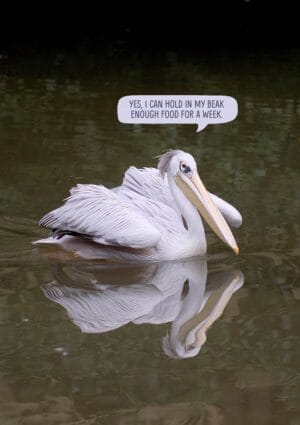Your basket is currently empty!
Inside A Pelican’s Beak

What it is like inside a pelican’s beak? Do pelicans have teeth?
What does it feel like if you put your hand inside a pelican’s beak?
Back in May 2016, my wife Tamara and I went to Edinburgh Zoo. And we saw the pelicans. That wasn’t the first time. We had been many times before. But this time the pelicans were close by a fence, clustered together.
They have a large pond and the banks of the pond to walk about on. And they seemed happy in their environment.
I know some people have a thing about zoos, and think they are cruel. And some zoos do have cramped quarters, and of course freedom is not to be dismissed.
But zoos worldwide do some of the most important conservation work. So except where animals are obviously unhappy, I am not going to criticise zoos.
Of course, if all animals and birds were in zoos that would be a sad day for mankind. I recall seeing pelicans flying overhead off the coast of northern California.
It was a magnificent, almost prehistoric sight. And I guess that the pelicans in Edinburgh Zoo would be happy to join their brothers flying free. But still, on balance, zoos do good work.
Pelicans Are Social
Pelicans are social. We could see that because as soon as one of them found something interesting to investigate the others would follow. They would gather round and huddle close to one another.
The pelicans were so friendly that two of them reached up to say hello to us.
And Tamara and I had the experience of holding out our hands and feeling pelican’s beak close around them.
Inside A Pelican’s Beak
This is what it felt like when the pelican closed its beak on my hand. The upper beak felt like I was being tapped gently with a thin piece of lightweight wood. It was pleasant being investigated delicately by a large bird.
When the pelican closed its beak around my hand, the edge of the beak rasped against my hand as though with very tiny teeth. They were not sharp – just a faint rasp as they closed around my hand.
So do pelicans have teeth? They have they have small, tooth-like ‘denticles,’ that help them hold onto slippery fish. And the denticles are so the pelican can drain water from its throat pouch.
They need to drain water when the pelican folds its wings, dives into the water, and rises to the surface with fish in its beak.
Because the lower beak is stretchy and translucent, light shines through it and illuminates the inside. Tamara noticed this, and soon we both experienced seeing all the way down the pelican’s throat into its gullet.
Inside the beak of a pelican is like a highway illuminated by yellow light.
Dixon Lanier Merritt’s Limerick
Dixon Lanier Merritt’s limerick (with several variations) springs to mind when talking about pelicans:
A wonderful bird is the pelican,
His bill will hold more than his belican,
He can take in his beak
Enough food for a week,
But I’m damned if I see how the helican.
A wonderful bird is the pelican
Its beak can hold more than its belly can
It can hold in its beak
Enough food for a week
A wonderful bird is the pelican
The Pelican Greeting Card
We photographed pelicans in the South west of England and used this photograph for our greeting card with the pelican saying Yes, I can hold in my beak enough food for a week!